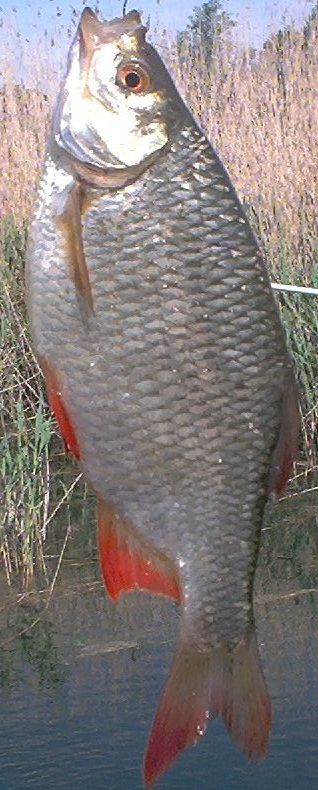- Common Rudd
Taxobox
name = Common Rudd

status = LR/lc | status_system = IUCN2.3
regnum =Animal ia
phylum = Chordata
classis =Actinopterygii
ordo =Cypriniformes
familia =Cyprinidae
genus = "Scardinius "
species = "S. erythrophthalmus "
binomial = "Scardinius erythrophthalmus"
binomial_authority = (Linneaus,1758 )The Common Rudd ("Scardinius erythrophthalmus") is a small
fish , a widespread member of the familyCyprinidae . Locally it is simply called "the rudd", but this may refer to anyspecies in thegenus "Scardinius ".The rudd is a bentho-
pelagic freshwater fish, widely spread inEurope and middleAsia , around the basins of the North, Baltic Black, Caspian andAral sea s. It has been artificially introduced toIreland ,USA ,Morocco ,Madagascar ,Tunisia ,New Zealand ,Canada andSpain .Identification
Morphologically, this species is very similar to the Roach ("Rutilus rutilus"), with which it can be easily confused. It can be identified by the yellow eye colour. The eye of the Roach has a big red spot above the pupil, that can be more or less conspicuous. The placement of the dorsal fin is more to the rear which is even visible in very young fish. There are normally two scales between the pelvic and anal fins, while on the roach there are five. Also the skin of the Rudd is yellowish green, while the roach is bluish on the flanks. Also the upturned mouth is visible even in young fish. Furthermore the rudds number of soft rays in the
dorsal fin (8-9 compared to 10-12). There can be confusion with the ide also which has smaller scales however.The Rudd can grow to a size of a about 45 cm.
Ecology
Rudd prefer clear waters rich in plants. They also feed on aquatic vegetation when the temperature exceeds 18 oC. They hunt for living prey in the upper levels. They prefer mesostrophic waters, while the roach is sometimes found together with the
perch in waters that are nutrient poor.Hybrids
This species can hybridise with virtually all other
cyprinids producing intermediate forms. Sometimes hybrids are produced artificially for angling purposes.The Rudd has an upturned mouth because it is easy for them to feed at the top of the water
In New Zealand and Canada it is considered a pest fish due to impacts on native species.
References
*
*
Wikimedia Foundation. 2010.
